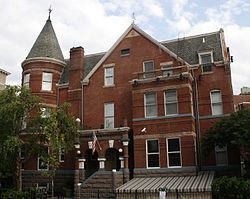Laogai Museum
 Former residence now home to the Laogai Museum | |
Location within Washington, D.C. | |
| Established | November 12, 2008 |
|---|---|
| Location | 1901 18th Street NW Washington, D.C. (formerly 1734 20th St. NW, Washington D.C., United States; initially at 1109 M Street NW, Washington, D.C). |
| Coordinates | 38°54′24″N 77°01′39″W / 38.9067°N 77.0276°W |
| Type | Prison museum |
| Public transit access | |
| Website | laogairesearch.org |
The Laogai Museum is a museum in Dupont Circle, Washington, D.C., United States, which showcases human rights in the People's Republic of China, focusing particularly on Láogǎi, the Chinese prison system of "Reform through Labor".[1][2] The creation of the museum was spearheaded by Harry Wu, a well-known Chinese dissident who himself served 19 years in laogai prisons;[1][2] it was supported by the Yahoo! Human Rights Fund.[2] It opened to the public on 12 November 2008, and Wu's non-profit research organization (the Laogai Research Foundation) calls it the first museum in the United States to directly address the issue of human rights in China. It is now permanently closed.[2][3]
Overview[edit]
The Chinese penal system includes numerous components such as prisons (formerly referred to as laogai), re-education through labor or laojiao camps, ankang mental health facilities, and juvenile detention centers.[4] The Laogai Museum focuses mainly on the laogai component, which Wu's non-profit research organization calls "the most extensive system of forced labor camps in the world.".[2] Prisoners in these camps are said to undergo forced labor and thought reform,[4] and the system has attracted widespread criticism from the international community. In 1994, the government abandoned the term laogai and renamed the facilities "prisons" (jianyu), but the Laogai Research Foundation and others claim that forced labor continues and prison conditions have not improved.[1][5]
The purpose of the Laogai Museum, according to Wu, is both to educate the public about the laogai and to memorialize the victims of the laogai.[2] The museum documents the "history and structure of the laogai," and displays laogai-related materials such as uniforms, photographs, government documents, and products manufactured by prisoners[2]—including such items as Christmas lights, tea bags,[3] and plastic flowers;[6] many of the items were donated by laogai survivors, and others come from Wu's own archives.[6] The museum also has a large archive of prison-made products, victims' testimonies,[6] and Chinese government documents.
The museum appeared to have closed in early 2017[7] following the death of its founder in April 2016,[8] who had been criticised for excessive spending on the museum, rather than on human rights activists themselves. The museum reopened in October 2018.[9]
Funding[edit]
The museum was funded in part by the Yahoo! Human Rights Fund, a fund established by Yahoo! after the company attracted criticism for helping Chinese police locate and detain internet dissidents.[1][3] The fund, headed by Yahoo! co-founder Jerry Yang was part of Yahoo!'s apology, and funding the museum was one of its first public projects.[10]
Criticism[edit]
A spokesman for the Chinese embassy has criticized the museum, calling it an attack on China's reputation and suggesting that Wu's motivation behind opening the museum was "to vilify the Chinese legal system and mislead the American public."[6] In response, Wu said that the Chinese authorities "always dismiss me as a morally corrupt and dangerous criminal. Their second argument is that criminals have to work in some American prisons, too. But I can tell you that it's not the same thing at all."[6]
References[edit]
- ^ a b c d Agence France-Presse (10 November 2008). "US museum displays China's 'laogai'". Taipei Times. Retrieved 12 December 2008.
- ^ a b c d e f g "Press Release: Laogai Museum Now Open to the Public". Laogai Research Foundation. 13 November 2008. Archived from the original on January 22, 2009. Retrieved 12 December 2008.
- ^ a b c Kusimi, John (17 November 2008). "Harry Wu Opens New Laogai Museum in DC". China Support Network. Retrieved 12 December 2008.
- ^ a b "Laogai Handbook" (PDF). www.laogai.org. The Laogai Research Foundation. 2006. Archived from the original (PDF) on 27 May 2008. Retrieved 18 October 2008. p. 16.
- ^ "Chongqing: China allows counsel for reeducation-through-labor cases". laogai.org. Laogai Research Foundation. 4 April 2007. Archived from the original on April 30, 2009. Retrieved 2008-10-22. Translated from Chinese, original source was 海涛 (4 April 2008). "中国重庆允许律师代理劳动教养案". www.voanews.com. Voice of America. Retrieved 2007-04-04.
- ^ a b c d e Buffard, Anne-Laure (14 November 2008). "D.C. museum 1st in U.S. to look at Beijing's prison system". The Washington Times. Retrieved 12 December 2008.
- ^ Noonan, Anne. "Ann Noonan Speaks at Beijing Spring's Tiananmen Square Massacre Memorial". CUSIB. The Committee for U.S. International Broadcasting (CUSIB). Retrieved 19 September 2018.
- ^ Jacobs, Andrew (3 Aug 2016). "Champion of Human Rights in China Leaves a Tarnished Legacy". New York Times. Retrieved 19 September 2018.
- ^ Fan, Yang (December 24, 2018). "The Reopening of the Laogai Museum and the Formation of a New Board of Directors". China in Perspective. Retrieved 15 January 2019.
- ^ Fowler, Geoffrey A (12 November 2008). "Yahoo-Sponsored Chinese Human Rights Museum Opens in Washington". The Wall Street Journal. Retrieved 12 December 2008.
External links[edit]
- Laogai Museum
- VOA Covers grand opening of New Museum (video) (in Chinese)
- Voice of America Covers Opening of Laogai Museum (video) (in Chinese)
- News relating to Laogai Museum from ObserveChina


 French
French Deutsch
Deutsch